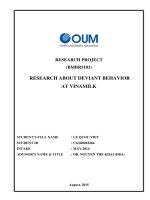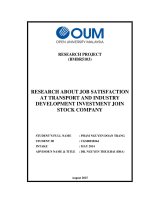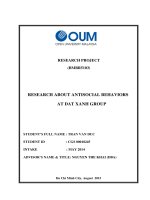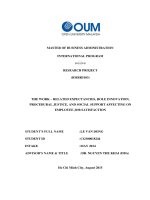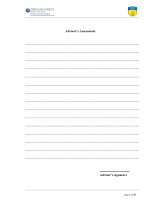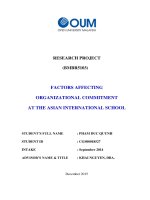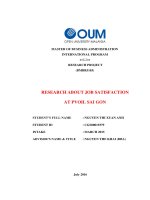Research about organizational commitment at PV engineering
Bạn đang xem bản rút gọn của tài liệu. Xem và tải ngay bản đầy đủ của tài liệu tại đây (1.36 MB, 60 trang )
MASTER OF BUSINESS ADMINISTRATION
INTERNATIONAL PROGRAM
RESEARCH PROJECT (BMBR5103)
RESEARCH ABOUT
ORGANIZATIONAL COMMITMENT AT
PV ENGINEERING
STUDENT’S FULL NAME:
NGUYEN KHAC CHUONG
STUDENT ID:
CGS00019364
INTAKE:
MARCH 2015
ADVISOR’S NAME & TITLE:
NGUYEN THE KHAI (DBA)
ADVISOR’S ASSESSMENT
..……………………………………………………………………………………………………………..
……………………………………………………………………………………………………………….
……………………………………………………………………………………………………………….
.………………………………………………………………………………………………………………
……………………………………………………………………………………………………………….
……………………………………………………………………………………………………………….
.………………………………………………………………………………………………………………
……………………………………………………………………………………………………………….
……………………………………………………………………………………………………………….
.………………………………………………………………………………………………………………
……………………………………………………………………………………………………………….
……………………………………………………………………………………………………………….
.………………………………………………………………………………………………………………
……………………………………………………………………………………………………………….
……………………………………………………………………………………………………………….
.………………………………………………………………………………………………………………
……………………………………………………………………………………………………………….
……………………………………………………………………………………………………………….
.………………………………………………………………………………………………………………
……………………………………………………………………………………………………………….
……………………………………………………………………………………………………………….
.………………………………………………………………………………………………………………
ADVISOR’S SIGNATURE
NGUYEN THE KHAI (DBA)
TABLE OF CONTENTS
TABLE OF CONTENTS .................................................................................................... 1
LIST OF FIGURES ............................................................................................................. 2
LIST OF TABLES ............................................................................................................... 3
ABBREVIATIONS .............................................................................................................. 4
ABSTRACT .......................................................................................................................... 5
CHAPTER I - INTRODUCTION ...................................................................................... 6
1.1 Company Introduction ................................................................................................. 6
1.2 Research problem statement ...................................................................................... 12
1.3 Research Objectives ................................................................................................... 13
1.4 Research scope ........................................................................................................... 13
1.5
Significance of research ........................................................................................ 13
CHAPTER 2. LITERATURE REVIEW ......................................................................... 15
2.1 Organizational Commitment. ..................................................................................... 15
2.2 Perceived Organizational Support.............................................................................. 17
2.3 Work – Related expectancies ..................................................................................... 18
2.4 Empowerment at Work Scale..................................................................................... 20
2.5 Perceived Person – Organization Fit .......................................................................... 21
CHAPTER 3: RESEACH MODEL AND HYPOTHESES ........................................... 24
3.1 Research Model .......................................................................................................... 24
3.1.1 Dependent Variables: ...........................................................................24
3.1.2
Independent Variables: .....................................................................24
3.1.3 Constructs .............................................................................................24
3.2 Research Hypotheses ................................................................................................. 25
3.3 Instruments ................................................................................................................. 27
3.4 Research Participants ................................................................................................. 31
3.5 Procedure for Data Collection and Analyze............................................................... 32
CHAPTER IV: ANALYSIS AND RESULTS ................................................................. 34
Cronbach’s Alpha of constructs ....................................................................................... 34
4.2 Reliability Analysis .................................................................................................... 36
Business Research Methods
4.3 Descriptive Analysis .................................................................................................. 37
4.4 Correlation of all variables statistics .......................................................................... 37
4.5 Hypotheses Testing .................................................................................................... 39
CHAPTER V: CONCLUSION......................................................................................... 43
5.1 Summary and Discussion: ......................................................................................... 43
5.2 Management Implications: ......................................................................................... 43
5.3 Limitations and Further Research Recommendation: ................................................ 45
REFERENCES................................................................................................................... 47
APPENDIX 1 ...................................................................................................................... 49
APPENDIX 2: PRESENTATION .................................................................................... 54
NGUYEN KHAC CHUONG CGS00019364
Page 1
Business Research Methods
LIST OF FIGURES
Figure 1: PVE management organization………………………………………….11
Figure 2: Shareholders Structure …………………………………………………..12
Figure 3: Proposed Research Model of Organizational Commitment in PVE ……27
NGUYEN KHAC CHUONG CGS00019364
Page 2
Business Research Methods
LIST OF TABLES
Table 1: Cronbach’s Alpha Internal consistencty………………………………….34
Table 2: Cronbach’s Alpha of Organizational Commitment…………………...…34
Table 3: Cronbach's Alpha of Perceived organizational Support………...………..35
Table 4: Cronbach's Alpha of Work-Related Expectancies………………...……...35
Table 5: Cronbach's Alpha of Empowerment at Work Scale……………...……...36
Table 6: Cronbach's Alpha of Perceived Person-Organization Fit………………..36
Table 7: Summary of Cronbach's Alpha of the variables……………………...…..37
Table 8: Descriptive statistics……………………………...………………………38
Table 9: Summary of correlations of all variables………...……………………….39
Table 10: Model summary of H1………………………………………...………...40
Table 11: Coefficients of H1…………………………………...……………….….40
Table 12: Model summary of H2...………………………………………………...41
Table 13: Coefficients of H2…………...…………………………………………..41
Table 14: Model Summary of H3…...……………………………………………..42
Table 15: Coefficients of H3……..………………………………………….…….42
Table 16: Model Summary of H4……..….………………………………………..43
Table 17: Coefficients of H4…………..…………………………………………..44
NGUYEN KHAC CHUONG CGS00019364
Page 3
Business Research Methods
ABBREVIATIONS
PVE
PV Engineering
HRM
Human Resource Management
HRMS
Human Resource Management System
HRC
Hot Rolled Coil
SPSS
Statistical Packages for the Social Science
OC
Organizational Commitment
POS
Perceived Organizational Support
WR
Work – Related Expectancies
EW
Empowerment at Work Scale
POF
Perceived Person – Organization Fit
NGUYEN KHAC CHUONG CGS00019364
Page 4
Business Research Methods
ABSTRACT
In the perspective of company culture in Vietnam, employee’s turnover reflects the
completeness of the company’s policies, the culture of management, and the
tendency of success or failure of organization’s overall business strategy, especially
in big company with a large scale of employees like PV Engineering company
(PVE).
PVE recent reports indicate that employees in this group have tendency to leave the
company after specific time in service. There could be several significant reasons
affecting organizational commitment of PVE employees. This research project
focuses on examining and approaching whether items in terms of Empowerment at
Work Scale, Perceived Organizational Support, Perceived Person – Organization fit
and Work-Related Expectancies will have any influence on the organizational
commitment of PVE employees.
Questionnaires were delivered to 340 employees in different background of
educational degrees, years of service, gender, years of age as well as work positions.
All of these employees mostly worked in Head quarter of PVE in Ho Chi Minh city.
263 samples were returned and put into further researched and analyzed practices.
The reliability analysis, descriptive analysis, and hypothesis testing were statically
measured in the study with the support of SPSS software.
Results showed that in the four participating independent structure with structural
test depends, then all four structural support for the dependent variable. The staff
felt when Evoking organizations and are empowered in functional tasks, organized
to support and meet the expectations related to work longer, the commitment
displayed staff their organizations
NGUYEN KHAC CHUONG CGS00019364
Page 5
Business Research Methods
CHAPTER I - INTRODUCTION
1.1 Company Introduction
About PV Engineering
Joint Stock Company Investment Consulting and Design Petroleum was founded
from the equitization of State-owned Enterprises Company Construction Investment
Consulting Petroleum (PVICC).
• Day 10/04/1998: PVICCC, is a member of the Petroleum Corporation of Vietnam
(PVN)
• On 02/27/2002: Renamed transaction PVICCC Company Investment Consulting
& Design Oil and Gas and the abbreviated name of PetroVietnam Engineering
Company (PV Engineering).
• On 03/26/2004: Transform into JSC Investment Consulting and Design
PetroVietnam (PV ENGINEERING JSC) with a total charter capital of VND25
billion and to date raised 11/08/2009 80 billion.
For over 10 years, the leadership and all employees PV Engineering not strive,
strive to complete projects in the field of consulting, design and project
management; construction and installation and inspection surveys, a significant
contribution to the development of Vietnam Oil and Gas Group.
+ Activities consulting, design and project management: a series of key projects
such as DK sector: Project development planning Binh Thuan gas industry; Project
planning gas supply system Southern; Pipeline project Phu My - Ho Chi Minh City;
Project pipeline PM 3 - Ca Mau; Combination Gas - Electricity Ca Mau; Offshore
Pipelines Dawn - White Tiger, etc ... Currently, the Company is implementing the
feasibility study report and development projects: Project pipeline Black Lion /
Golden Lion - Dawn; Project Development Planning of Vietnam Oil and Gas sector
for 2006-2015, with a vision to 2025; gaslift system design for drilling rigs;
NGUYEN KHAC CHUONG CGS00019364
Page 6
Business Research Methods
engaged in design works in Nhon Trach 2 power plant, Dinh Vu polyester plant,
factory Bio-ethanol fuel ...
+ Construction and installation activities: participation in construction of oil and gas
projects, such as oil refinery Dung Quat Oil Refinery No. 1; Polypropylene
production plant - Dung Quat; Gas pipeline and the PM3-Ca Mau station; CNG Phu
My plant; Liquefied petroleum gas plant in Dong Nai; Gas processing plant Dinh
Co GPP; LPG depots Hai Phong; Hanoi LPG filling stations; Dinh compressor
stations; Nam Con Son Condensate Project; Phu My Fertilizer Plant; .... In addition,
the company also participated in the construction and maintenance of oil and gas as
fixed rig repair Vietsovpetro, repairing corrosion-resistant pneumatic, fuel depots,
and so the pressure equipment ...
+ Conducting sá and verification: Besides, PV Engineering is also involved in other
activities such as surveying and engineering services, nondestructive testing, quality
testing project: Project Ring Road 2 - south of HCMC, gas pipeline project B52OMon, refinery 3 - Long Son, East-West gas pipeline South ...
PVE VISION TO 2025
Becoming one of the leading companies in Vietnam in the field of investment
consulting, design and provide full service or partial EPC projects in oil and gas
sector.
MISSION PVE
Provide products and services of high quality with competitive prices and friendly
environment to meet the needs, desires of the customer, which in turn brings higher
profit margins, stable for the neck east and created environmental and professional
challenges for staff.
CORE VALUES
Sharing knowledge
NGUYEN KHAC CHUONG CGS00019364
Page 7
Business Research Methods
+ We always share knowledge and see it as the property of the company to come up
with the ideas and the best solution for the job
+ Ethics we are honest, forthright, respect for the law, integrity with customers,
protect the environment, justice and equality in dealing with employees, provide
complete and accurate information to shareholders.
+ Quality We always strive to provide the best products and services, to ensure the
progress, quality, efficiency, safety, high reliability, continuous training and
development of human resources, increase investment in technical equipment and
technology, research and application of effective management methods and modern.
PV Engineering has successfully completed many major projects with Petro
Vietnam and other international partners. We continue to develop more consultancy
services in such areas as: Offshore; Gas Pipeline; Gas Processing Plant;
Petrochemical Plant (such as polypropylene, fertilizer plants); Gas power, coal
power; wind power and hydropower plants; Bio-Ethanol plants; and in industrial
and civil projects
We provide expert services in: FS; FEED, detailed engineering; General cost
estimation; Procurement support; Survey and inspection; Project management
consultancy
PV Engineering at a glance
Head office
10th Floor, PVGas Tower, 673 Nguyen Huu Tho, Nha Be,
HCMC, Vietnam
Founders
PetroVietnam
NGUYEN KHAC CHUONG CGS00019364
Page 8
Business Research Methods
Date of
April, 1998
establishment
Scope of Work
- Engineering Consultancy
- EPC/ Construction/ Installation
- Project Management Consultancy
-Survey&Inspection
Market
217,5 billion VND (as of May 2016)
capitalization
Number of
650 (as of December 2015)
employees
Stock exchange
HNX (Ha Noi Stock Exchange, Vietnam)
NGUYEN KHAC CHUONG CGS00019364
Page 9
Business Research Methods
Organization Structure
Figure 1: PVE Organization structure
Share capital/ Shareholders’ structure
PetroVietnam is founding shareholder and also the main shareholder of the Group
as at 31 May 2016, currently hold 7,250,000 shares, equivalent to 29% of total
shares in circulation of the Group,the average investors are some domestic and
foreign organizations, the individuals just take a small part of the investment.
SHARE
Number of common shares issued to public
Number
of
outstanding
common
shares
25,000,000
in
25,000,000
circulation
Number of transferable common shares
Par value (VND/shares)
25,000,000
VND 10,000
SHAREHOLDER'S STRUCTURE (Updated list of shareholder 31/05/2016)
NGUYEN KHAC CHUONG CGS00019364
Page 10
Business Research Methods
Ratio
Petrovietnam (state shareholder)
7,250,000
Technip Malaysia
2,500,000
Viet Nam Equity Holding
1,482,675
Vietnam Holding Ltd.
1,177,440
Individual
12,500,000
TOTAL
25,000,000
29%
50%
10%
5.93%
4.71%
Figure 2: Shareholders structure
There is no separation between management and ownership of the company, the
Board of Directors, President and CEO, the Supervisory Board and the shareholders
have closely coordinated in order for the corporation to achieve operational
efficiency, complying with the Regulations of the Corporation and State law. The
Board of Directors monitored and gave direction to the Board of Management for
the operation of the Corporation in order to fulfill the business plan assigned by
AGM. PV Engineering’s Board of Directors was always considered a united
assembly with valuable knowledge, expertise with the management experience that
is fair, objective and motivated in expanding the corporation. The Board of
Directors has successfully determined the management strategy for the
corporation’s business strategy.
All resolutions and decisions from the Board of Directors are made with a firm and
unified decision from all or most of the members of the Board on the basis of
shareholders’ interest and the sustainable development of the Corporation.
NGUYEN KHAC CHUONG CGS00019364
Page 11
Business Research Methods
1.2 Research problem statement
Currently, in the context of the overall impact of oil prices plummeted, businesses
in the fields of design consultancy specialized in oil and gas encountered many
difficulties and PVE is not an exception, there are too many changes but not any
research looking for the organizational commitment of employees at these
companies.
PVE is a positive development and human resource development, especially in
choosing the right person for the company. However, recruiting the right people is
not enough and they are perplexed to know how to keep talented employees, retain
talent, especially how to retain their key staff have played a important role in the
company. With the shortage of human resources at present, retaining good people is
becoming the major issue of the PVE
PVE has focused on its HRM by providing a lot of activities to strengthen its human
resource training and development such as coordinating with universities in HCM
city and Hanoi city to recruit potential candidates, conducting variety of internal
training programs. Besides, PVE also provide many HR management policies to
retain and develop its workforce such as salary and reward systems.
However, as stated in its annual human resource reports, the number of employees
quit jobs gets increasing year over year. That may lead the company to critical
impact of leaking its skilled and well trained workforce. Not only that, it will take
huge invisible cost for the company if these well trained and qualified employees
run out of the company and come to work for the competitors.
With the above real situation and also for the long term strategic human resource
management, it is critical to examine and analyze the diversified relationships of
organizational commitment among PVE workforce.
NGUYEN KHAC CHUONG CGS00019364
Page 12
Business Research Methods
1.3 Research Objectives
The purpose of this research is to examine and approach whether items in terms of
Perceived Organizational Supoort, Work – Related expectancies, Empowerment at
Work Scale, and Perceived Person – Organization Fit will have any influence on the
organizational commitment of PVE employees.
It is believed that the findings of the study will provide an overview of how to
manage internal items affect the turnover rate of the PVE. Then, the management
team can result PVE of the project is a reference to the adjustment and development
of several solutions that can fill the gaps in human resource management systems
and maintain talent her to carry out her vision is to become a leading company in
Vietnam in the field of design of oil and gas projects
1.4 Research scope
The scope of research is for the entire employees at PV Engineering, includes:
leadership team, employees and direct supervisors in different departments include
commercial & Marketing, Business Development, Finance accounting and
Information Technology, and design.
A series of formed questionnaire was distributed to each employee with clear
instructions and guidelines for fulfillment.
The survey scope is within the territory of Vietnam, which includes 340 employees
of PVE.
Contents of this research are only including factors influencing to organizational
commitment at PV Engineering; it does not have intention of re-structuring,
changing and replacing the employees.
1.5 Significance of research
This research will help CEO, Directors; managers understand and are more aware of
the importance of Organizational commitment. That is the most important factor to
show the effectiveness of the policy, the organization operating concept in human
matters.
NGUYEN KHAC CHUONG CGS00019364
Page 13
Business Research Methods
Besides significant management, it also improves employee loyalty to the
organization and further, employees will be loyal to the shareholders of the
company, contributed to the financial strength of the companies increasingly
stronger in the future.
NGUYEN KHAC CHUONG CGS00019364
Page 14
Business Research Methods
CHAPTER 2. LITERATURE REVIEW
2.1 Organizational Commitment.
According to the business dictionary, organizational commitment is defined as
the strength of feeling of responsibility that an employee has towards to mission of
the organization.
In organizational behavior and industrial and organizational psychology,
organizational commitment is the individual’s psychological attachment to the
organization. Many studies was initially aimed at finding ways to improve how
employees feel about their work and helping them become more committed to the
organization. Organizational commitment predicts work variables such as job
performance, turnover and organizational citizenship behavior1.
Alot of scientists have developed various definitions of organizational
commitment, and there are numerous scales to measure them. Meyer and Allen's
model of commitment is an exemplary of this work.
According to Meyer and Allen's (1991) three-component model of
commitment was created to argue that commitment has three different components
that correspond with different psychological states. Meyer and Allen created this
model for two reasons: "aid in the interpretation of existing research" and "to serve
as a framework for future research”. Their research was based mainly around
previous researches of organizational commitment. Meyer and Allen’s research
indicated that there are three "mind sets" which can characterize an employee's
commitment to the organization:
Firstly, Affective Commitment is defined as the employee's positive emotional
attachment to the organization. Meyer and Allen pegged Affective Commitment as
1
Source: />
NGUYEN KHAC CHUONG CGS00019364
Page 15
Business Research Methods
the “desire” component of organizational commitment. An employee who is
affectively committed strongly identifies with the goals of the organization and
desires to remain a part of the organization because he/she want to do so (Cohen,
1993). This commitment can be influenced by many different demographic
characteristics: age, sex, tenure, and education but these influences are neither
strong nor consistent. The problem with these characteristics is that while they can
be seen, they cannot be clearly defined. Meyer and Allen gave this example that
“positive relationships between tenure and commitment maybe due to tenure-related
differences in job status and quality”. In developing this concept, Meyer and Allen
drew largely on Mowday, Porter, and Steers's (2006) concept of commitment,
which in turn drew on earlier work by Kanter (1968).
Secondly, Continuance Commitment is the “need” component or the gains
verses losses of working in an organization. “Side bets,” or investments, are the
gains and losses that may occur should an employee stay or leave an organization.
An employee may commit to the organization because he/she perceives a high cost
of losing organizational membership (cf. Becker's 1960 "side bet theory". Things
like economic costs (such as pension accruals) and social costs (friendship ties with
co-workers) would be costs of losing organizational membership. But an individual
doesn’t see the positive costs as enough to stay with an organization he/she must
also take into account the availability of alternatives (such as another organization),
disrupt personal relationships, and other “side bets” that would be incurred from
leaving his/her organization.
Finally, Normative Commitment reflects a feeling of obligation to continue
employment. Employees with a high level of normative commitment feel that they
ought to remain with the organization (Meyer & Allen, 1997). The feeling may
derive from an agreement on an individual before and after joining an organization.
NGUYEN KHAC CHUONG CGS00019364
Page 16
Business Research Methods
For example, the organization may have invested resources in training an employee
who then feels a 'moral' obligation to put forth effort on the job and stay with the
organization to 'repay the debt.' It may also reflect an internalized norm, developed
before the person joins the organization through family or other socialization
processes, that one should be loyal to one's organization. The employee stays with
the organization because he/she "ought to". But generally if an individual invest a
great agreement, he/she will receive “advanced rewards.” Normative commitment is
higher in organizations that value loyalty and systematically communicate the fact
to employees with rewards, incentives and other strategies. Normative commitment
in employees is also high where employees regularly see visible examples of the
employer being committed to employee well-being. An employee with greater
organizational commitment has a greater chance of contributing to organizational
success and will also experience higher levels of job satisfaction. High levels of job
satisfaction, in turn, reduces employee turnover and increases the organization’s
ability to recruit and retain talent.
2.2 Perceived Organizational Support.
It was developed by Eisenberger et al (1986), describes employee perception about
extent to which organization is willing to reward greater efforts by the
employee because the organization values the employee’s contribution and his or
her well being. It includes 8 items.
Research on Perceived Organizational Support began with the observation that
managers' concern with their employees' commitment to the organization is
positively correlated with employees' focus on the organization's commitment to
them. For employees, organizations serve as important sources of social emotional
resources like respect and care, as well as tangible benefits like wages and medical
benefits.
NGUYEN KHAC CHUONG CGS00019364
Page 17
Business Research Methods
Being regarded highly by the organization helps to meet employees' needs for
approval, esteem and affiliation.
Positive evaluation by the organization also provides an indication that increased
effort will be noted and rewarded.
Employees, therefore, take an active interest in the regard with which they are
held by their employer.
Perceived Organizational Support can also be used to offer an explanation for
organizational cynicism. Organizational cynicism is related to job satisfaction; it is
an attitude toward an organization reflecting one's beliefs about his or her
experience as part of the organization. Just as Perceived Organizational Support
explains
employees’ feelings of value, meaning, identity, etc., it explains
employees' feelings of discouragement and distance from their organization.
Psychologist James Dean studied employees and found that the biggest cause of
cynicism was change that was perceived to be out of the employee's control.
Eisenberger and Rhoades found that changes made within the organization were
less supported by employees when the changes were perceived to be out of their
control
2.3 Work – Related expectancies
Employees believe that higher levels of job performance will be rewarded and
employee expectancies about the relationship of better performance with increased
pay, promotion, and job security. It also assesses employee expectancies that better
performance will lead to increased influence, supervisory approval, and recognition
(Eisenberger, Fasolo, and Davis-LaMastro.,1990).
There are two factors for work-related expectancies. One dimension captures
expectancies about pay and promotion rewards. The other dimension describes
expectancies about approval and recognition. The two factors were consistent
NGUYEN KHAC CHUONG CGS00019364
Page 18
Business Research Methods
across samples of hourly workers and managers. Expectancies for pay/promotion
rewards and approval/recognizational support, job satisfaction, participation in
decisions, and job involvement. (Eisenberger et al.,1990; Smilth & Brannick, 1990).
Individuals high in the first three desires, referred to as “motivator” desires,
were establish to favor a pay for performance system more than individuals low in
these needs (Bajpai & Srivastava, 2002).
Fair upgrading policies and practice provide chances for personal
development, more tasks and increased social condition. When a person get fair
upgrading which is usually his true evaluation, he gets a type of acknowledgment
and hence job satisfaction. It amplifies worker perception to the excellence of their
job and improves both their job satisfaction and organizational commitment
(Luthans, 2005:212).
The workers who value opportunity for evolution display a high degree of job
participation in the wishes of solicit such compensation. Naturally, if workers do
not perceive development chances materialized, this outcome will be lost. Even
though condemn for various causes, the hierarchical and insular kind of country
civil service systems do give for transparent and expected inner progress (Manzoor
et al., 2011).
Adequate salary structure is linked with job satisfaction (Bajpai & Srivastava,
2002; Marginson, 2003). The characteristic of education depends on the incentive
for teaching performance determined by the academia, which, sequentially depends
on the marginal dollars of university income produce from education excellence
(Marginson, 2003).
Worker’s reward refers to all forms of pay or rewards available to workforce
and arising from the service (Dessler, 2005:410; Fattah, 2010). Money or other
monetary incentive in the classic performance exemplar is based broadly on the
NGUYEN KHAC CHUONG CGS00019364
Page 19
Business Research Methods
abstract propositions of reinforcement theory. Reinforcement theory concentrates
on the affiliation between the target behavior (performance) and its consequences
(pay) and is premised on the main beliefs and methods of organizational behavior
adjustment. Organizational behavior modification is a structure within which
worker behaviors are recognized, measured, and analyze in terms of their functional
consequences (existing reinforcements) and where an interference is developed
using values of reinforcement (Perry et al., 2006). Compensation systems have
impacts on the job satisfaction in both the public and private sector workers
(Getahun et al., 2007).
2.4 Empowerment at Work Scale
This measure, developed by Spreitzer (1995), describes the extent to which
employees believe they are empowered in their jobs. Empowerment has been
defined as the intrinsic motivation resulting from four cognitions reflecting an
individual’s orientation to his or her work role. The four cognitions are meaning,
competence, self-determination, and impact (Spreitzer, 1995). Meaning involves a
fit between the requirements of a work role and a person’s beliefs, values, and
behaviors. Competence refers to self-efficacy specific to work, a belief in one’s
capability to perform work activities with skill, analogous to personal mastery. Selfdetermination reflects autonomy over the initiation and continuation of work
processes and making decisions about work methods, pace, and effort. Impact is the
degree to which a person can influence strategic, administrative, or operating
outcomes at work.
A factor analysis showed that the 10 items all loaded on four factors corresponding to the dimensions of meaning, competence, self-determination, and
impact (Gagne et al., 1997). In Spreitzer (1995), confirmatory factor analysis
showed the items loaded on the appropriate subscales and found evidence for an
NGUYEN KHAC CHUONG CGS00019364
Page 20
Business Research Methods
underlying second-order factor of overall empowerment. In Kraimer, Seibert, and
Liden (1999), confirmatory factor analysis in two samples collected at different
points in time showed that the four empowerment dimensions were distinct from
one another.
The meaning, competence, self-determination, and impact dimensions all
correlated positively with job satisfaction (Spreitzer et al., 1997). In addition, all of
the dimensions except meaning correlated negatively with strain and positively
with self-reported job effectiveness. Additional analysis in Spreitzer (1995) showed
that self-esteem and information about an organization’s mission were both
antecedents of empowerment. In addition, both perceived managerial effectiveness
and innovative behaviors were consequences of empowerment. Using structural
equation models, Kraimer et al. (1999) found that job meaning fulness was related
positively with meaning, job autonomy was related positively with selfdetermination, and task feedback related positively with competence and impact.
Both meaning and competence were related positively with career intentions and
impact was related directly with organizational commitment.
2.5 Perceived Person – Organization Fit
Consideration of person-organization fit is based on the perspective that
aspects of both an individual employee and a job situation combine to influence the
individual’s response to work (O'Reilly, Chatman, & Caldwell, 1991). That is,
attitudes, behaviors, and other individual-level outcomes result not from the person
or environment separately, but rather from the relationship between the two. The
concept of fit is particularly prominent in studies of organizational stress where
measures must recognize individual differences in the way situations are cognitively
appraised (Edwards, 1996).
NGUYEN KHAC CHUONG CGS00019364
Page 21
Business Research Methods
Person-organization fit refers to the degree of congruence or compatibility
between the attributes of an organization member and those of the organization. For
individuals, these attributes may include personality traits, beliefs, values, and
interests. For the organization, these characteristics traditionally include the culture,
climate, values, goals, and norms (Chan, 1996). Congruence may occur when a
person supplements or matches with other individuals in an environment, when a
person’s characteristics add something to the environment that was missing, when
an organization satisfies individual needs, and/or when an individual has the
abilities required to meet organizational demands (Kristof,1996).
Value congruence is an important form of fit because organizational values are
fundamental components of organizational culture that affect employees’ attitudes
and behaviors (Chatman, 1989). Person-organization fit can be operationalized as
an individual’s goal congruence with organizational leaders and peers (Vancouver
& Schmitt, 1991). An alternative approach defines fit as the match between
individual preferences or needs and organizational systems and structures. In
general, a person will be more satisfied with work if the environment fulfills his or
her needs. Alternately, person-organization fit can be viewed as the match between
the personality characteristics of an individual employee and organizational climate.
For example, an organization’s collectivist climate may be reflected by a teambased compensation system that may or may not meet an individual’s need for
achievement (Kristof, 1996).
There is some debate as to whether person- organization fit should be
operationalized as the compatibility of employees with specific jobs. Edwards
(1991) defined person-job fit as the agreement between the abilities of a person and
the demands of a job or the desires of a person and the attributes of a job. Although
it could be argued that jobs tend to offer a narrow view that may not be
NGUYEN KHAC CHUONG CGS00019364
Page 22
